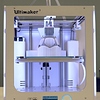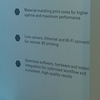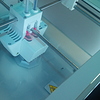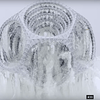Looks great, except I bought a 2+ only a couple of months back, and I’m not interested in coughing up that much cash for a replacement so soon.
If it had been available at the time it would have been a serious contender.
From what I’ve seen so far: Overpriced. Boring.
-Jesse
Priced as you would expect for an Ultimaker but I have one on order anyway. Trading up from one of my two Ultimaker 2+'s. I have had a dual extruder in the past and gave it up as not worth the hassle so will be interested to see if Ultimaker has gotten it right. Probably should have waited for some other folks to jump in first…but…what the hell, boys and their toys.
I think it will be a good machine for the professional market. But it won’t be for tinkeres and people that are just starting with 3d printing. The dual extrusions looks well engineered
I have been lucky enough to be part of the test group before the launch so i had the opportunity to use it for around 3 weeks now.
It’s a very good printer, dual extrusion works perfectly, the wifi/network connectivity is very usefull.
The print cores work flawlessly, i printed PLA, ABS, CPE, NYLON with no issues with the AA Core and PVA with the BB core
I agree that the price is a bit high, but really it’s worth it
It’s Awesome.
i also think a lot of people are missing the point here. this is not an UM2(+) replacement. it has a different audience…
if you need a reliable 3D printer for use at home and printing every now and then, or even on a very regular basis, and you are not afraid to do maintenance on them, then the UM2+ is the printer for you.
if you need a printer you can run 24/7, have high demands from and everything needs to be plug and play, the Um3 is for you.
so the prosumer/universities etc. of the world, they have a definitive benefit from this printer. for most peop[le at home, it’s nice, but I don’t see many advantages over the UM2+.
so I think it’s super exciting, and not overpriced at all…
Simply beautiful as all Ultimakers. I’m evaluating to sell my Ultimaker 2+ and get this one 
As espected from ultimaker, it is designed to be “perfect”. As they said a while back that dual extrusion needs to be done right, I think they nailed it with the UM3. Even the swappable printer cores is well designed.
As for the tinkerers there is still the UMO and the UM2. The UM3 looks to be made for the people who want a reliable printer without the hassle of having to tweak it yourself.
The price,… yeah it’s high. Too high for me too. But that also counts for apple products  and yet people still buy them because the quality is good.
and yet people still buy them because the quality is good.
The initial design and read up looks like they’ve ironed out some of the issues the Ultimaker 2 and 2+ had. I have a 2+ and I must say I’m looking forward to trying the 3. Dual extrusion was always a must for these machines.
I think It’s simply fantastic!
I would only do that if you really, really need dual extrusion. The UM2+ is a great machine.
I’m “this close” to ordering it, right off the bat. However, the price point is a bit steep for me, as an out-of-work student, so I’ll have to give it a month or two. Hopefully time for Simplify3D to come out with profiles for the UM3, as well as for them to fix any bugs in the firmware associated with rushing the product to market (which they admit doing).
It’s not going to replace my UM2+, rather work along side, providing me with remote control and most importantly of course the no-hassle dual extrusion, mainly for PVA support. I currently spend quite a bit of time cleaning up customer prints, due to the surprisingly large amount of overhangs people really seem to like. Looking forward to just dunking parts in water and seeing my problems dissolve. 
The one main issue I have with the Ultimaker 3 is the build volume. I’d really like to see Ultimaker come out with a 30x30x30 (12" for you Americans) or even slightly larger build volume printer, instead of just the height extended versions. Especially fabricating robot components sometimes needs the larger print bed, in my experience. Currently I do a _lot_ of PLA welding on components - I have a dedicated dremel just for PLA welding, which says a lot.
- So if anyone can recommend a larger dual extrusion printer with the same reliability of an Ultimaker, I think I won’t be bound to the brand.
I agree with you 100% on the fact that it’s not an UM2(+) replacement. It’s quite a different animal indeed.
The price point is up there, for sure, but again, it’s not a tinkertoy but a prosumer/professional machine. A lot of printers I’ve been looking at are priced either very similarly or at closer to the 6K or 9K mark, without necessarily having the reliability, build quality or HUGE community and support that the Ultimaker name provides.
Agreed. I’m keeping my UM2+ come hell of high water, but I am considering putting a UM3 next to it in my workshop, or possibly at the office I just rented for my association, with remote monitoring.
Its a nice machine, very good quality as usual from Ultimaker which will handle long and continuous print runs, dual printing at long last although I’m not sure if just the nozzles can be replaced or it’s a whole nozzle assembly, I would hope the nozzles can be changed and for different sizes aka the Olsson and match less. There are a few improvements overall which I would hope will be upgrades for the UM2, the stiffer build platform for one.
The price is a bit high for the home hobbyist so likely aimed at small business/small workshops, but I’m sure it’s worth the price.
It seems to have good connectivity, with LAN, WiFi and USB, and I like the integrated camera. And I would hope the camera could be another upgrade to the UM2.
I’m not sure that the UM3 is as user modifiable as the UM2 with the added complication in the print head.
Would I want one? Based on my experience with my pimped UM2, HELL YES, but with the pound at the moment I’ll have to wait a while.
It’s been mentioned a couple of times, but this really isn’t meant as a replacement for the UM2(+).
Ultimaker will keep selling the UM2+ as well as the UM original, alongside the new Ultimaker 3. - They are all aimed at different audiences.
Looks like it’s everything everyone wanted the UM2+ to be? Compare this to, for example the Felix Pro 1 (or newer Pro 2??) which has a very familiar feature set but a bigger build volume and a much better price, my choice would be simple. Also because I’ve seen some very impressive prints of the Felix Pro 1 printer, and with dual materials.
Running two UM2+'s at the moment of which I’m very satisfied with, I don’t think the UM3 will take place in my office very soon…
My understanding is that an 800 micron nozzle is planned first. This will be a whole core (95 quid) though not just the nozzle. I have asked about a 250 micron nozzle.
I am going to wait for some real youtube reviews, but I suspect I will buy one. I am not against tinkering with my UM2+ but the idea of a more reliable machine is appealing.
The Felix Pro 1 & 2 have a slightly larger print bed and with (from what I’ve seen) have a very good dual extrusion reliability and quality.
Ultimaker is a great brand of 3D printers and this is a valuable addition to the range.
A dual extruder adds significant advantages to a 3d printer both for personal and professional use and the webcam is a nice feature for remotely checking your prints. NFC tagging would not have been necessary since Cura already offers printing profiles and these also differ per print. A bigger build volume would have been nice but all in all I like the specs of this machine.
I think, that using: Ulticreatr 2X | Ulticreatr U might get same result using PVA or SM-310. So UM2(+) owners can use it.
Also autoleveling is done right with: http://3dprintingcenter.net/2016/05/14/odo-motion-a-sensor-for-auto-levelling-of-working-beds-of-3d-printers-available-in-the-offer-of-get3d/
IMHO Ultimaker haven’t done anything new, but they combine new ideas (like with Olson block before) to new printer.
Does UM3 worth it’s price? I think it does.
We had a look at Ultimaker 3 and therefore have to say, it is really a good machine! But as mentioned before, this is not a printer for everybody. This printer has been developed for business user and starts the combat with Stratasys & Co. And yeah, this is not a UM2++. Although the housing and gears are as before, the nozzle is completely new and no more usable with Olsson Block. You have to change the whole hotend unit, which comes from start only with 0.4mm Nozzle.
I have to say I’m not that impressed with what I’ve seen. The decision to go with two nozzles seems odd given that other manufacturers are looking more at single nozzles with multiple delivery systems and I’m concerned about the complexity of the lifting system (just one more thing to go wrong) and how effective it actually is. I’m also a little surprised they’re not full metal hot ends, and the emphasis on the 2.8mm size seems odd to me, like they know there’s an issue there and are forestalling complaints; it’s just an odd thing to put in a first release text.
On the price point, I have to compare it to the Prusa i3 Mk2. OK, that’s much more of a home user machine, but what does that really mean? The whole purpose of these things is to produce high quality prints reliably and if the Prusa can do that (and it sounds like it can), then why is the Ultimaker almost four times as expensive?
There is more to it than the two nozzles. Full metal can be added since the cores are easily swappable. Also the lifting mechanism has been tested for more than 10000 times (without any wear) according to Daid on the Ultimaker forums.
The wifi connectivity and the availability of the web-api on the printer makes it easy to use in a farm.
Check out the video below
And can you ship 1000 prusa i3’s Mk2 to a company and be sure they deliver thesame high quality? Ultimaker promises that, and that is why they are more expensive.
To be honest, @Rob_Leufkens, all that video says to me is that Ultimaker made a very poor job of planning and testing the machine. How did they get to production without properly testing the RFID reader? If they made that mistake, what others did they make?
As far as quality goes, I don’t know of any company that ships any product with the understanding that some of them might be poorly built and there’s absolutely no guarantee every single last one of the Ultimaker 3s will be perfect any more than any other printer.
As for order numbers, why should a product be more expensive simply because they can ship more of them? Surely prices should reduce with higher volume production, not increase, as it does with any other product. Not that I’m convinced they’re any more able to deliver a 1000 machine order than Prusa are; the video itself shows parts being printed, cleaned and assembled by hand, not an automated production line.
I get that there are going to be elements that mean this is a more expensive printer than the Prusa and that it’s probably more suitable for a farm/larger business, I do. But it’s four times more expensive, and that’s an awfully big hike.
We shall see…I am #1 in the order queue here in GB…
I agree that it’s (too) expensive. I was doubting about buying the printer and selling my own. But the price is indeed too high.
As stated ,on the um forums, they started experimenting with the dual extrusion after the UM2 released and they wanted to get it right (which i believe they have done that now) all this time and investment in research needs to be covered. and that offcourse comes down to the consumer which buys the printer.
I think you can compare it to the mobile market. Apple produces quality products for a high price, but you can get a cheap phone that does promises to do thesame thing. People still buy the quality product because they are ensured that it will keep working properly. Samsung tries to deliver both, release high end phones (S7 series, except the note hahaha) and cheap (A5) phones.
The prusa looks indeed like a very good printer, and the price is good indeed but it’s not targeted to the same audience hence the price difference also 
The base kit of the MK2 is cheap but you have to build it with all the problems that can lead to
You have to add an extra amount for the 4 feeder thing (which looks great i agree)
The MK2 is very opened so i guess (maybe i’m wrong) that ABS and such can be tricky
Not possible to print PVA!
No wifi connection/camera
And i really don’t agree with the one nozzle multiple extruder approach it’s very nice if you print the same material, but it’s impossible to print reliably different materials (and let’s not even talk about PVA).
So it’s not really comparable if you want my opinion 
Side note if someone is really eager to have one UM3 soon i’ll have one in stock tomorrow
It is just about 3 month that I bought an ultimaker 2+ 3D printer, but now I realize that I had to wait.
The thing I liked most was the dual extrusion and that they use PLA to support the pieces which melt with water.
I already asked to ultimaker whether they have an update to my printer and the answer was this:
“Sorry! we won’t be able to offer an upgrade kit for the Ultimaker 2 series, as too many parts have been changed between the two models.”.
How reliable would to add a dual extrusion with ulticretr? Can I invest $500us for this?
I know people who’ve made custom dual extruder set-ups for the UM original series, and I am sure it has been done for the UM2 as well. Go check out thw Ultimaker forums, I’m pretty sure there’ll be good documentation on the procedure.
I’m really not blown away by it, and while I don’t doubt Ultimaker’s quality, I am a bit skeptical of some of the design choices.
Dual extrusion via separate heads is a trend that is being moved away from in the industry for good reason. I am surprised to see them go down this route so late in the game, and I’m more than a little concerned about the longevity of the nozzle lifting mechanics. There’s a reason other manufacturer’s haven’t gone down this route; something like that requires very precise mechanics to get right every time. It is entirely possible that the nozzles “move” hundreds, if not thousands, of cycles per print (each could have to raise/lower multiple times per layer - imagine a couple thousand layer print at high resolution). It’s definitely the engineering brain raising a red flag with that - maybe I’m wrong and I hope I am, but I just don’t see that mechanism working precisely for a long period of time. Time will tell I suppose, but I’m not jumping at the gate to make a decent investment for a printer that may not work for that long.
Inclusion of the NFC also makes me a bit wary; this makes future implementation of DRM in the future very easy for the company and not something I want to deal with. Hopefully, they learned from the mistakes other companies have made with DRM and won’t even try going down that road.
My other issue is the build volume. It’s smaller than competing, similarly priced dual extrusion machines which I find kind of disappointing. I was really expecting a big volume with the UM3! I’ll make a final assessment after seeing this unit out in the wild for a couple months, and seeing how it stands up to wear and tear over time.
Once again, Ultimaker have blown our expectations out of the water with quality, features, design, and functionality.
The approach to Dual Extrusion is very interesting and definitely a lot easier than an E3D direct hotend with pneumatic connector seperated above it (An equivelant comparison to the UM3).
The webcam feature is interesting, I haven’t been able to find much information about it however the remote connectivity aspect and remote monitoring feature is something long overdue on the Ultimaker brand in my opinion.
The average price of a decently sized industrial-grade system would allow you to purchase more than 20 UM3’s. Which would give you more than 5x the build volume of the industrial system. Having multiple printers in your workshop/manufacturing line gives maximum flexibility (if 1 Ultimaker is out of use all other devices are still available, if one machine is down for maintenance the rest is still running). It can also be seen as a faster way to produce big objects, by splitting an object in different parts and printing it on multiple devices a cluster of UM3 is faster than any other big volume additive-manufacturing system available.





